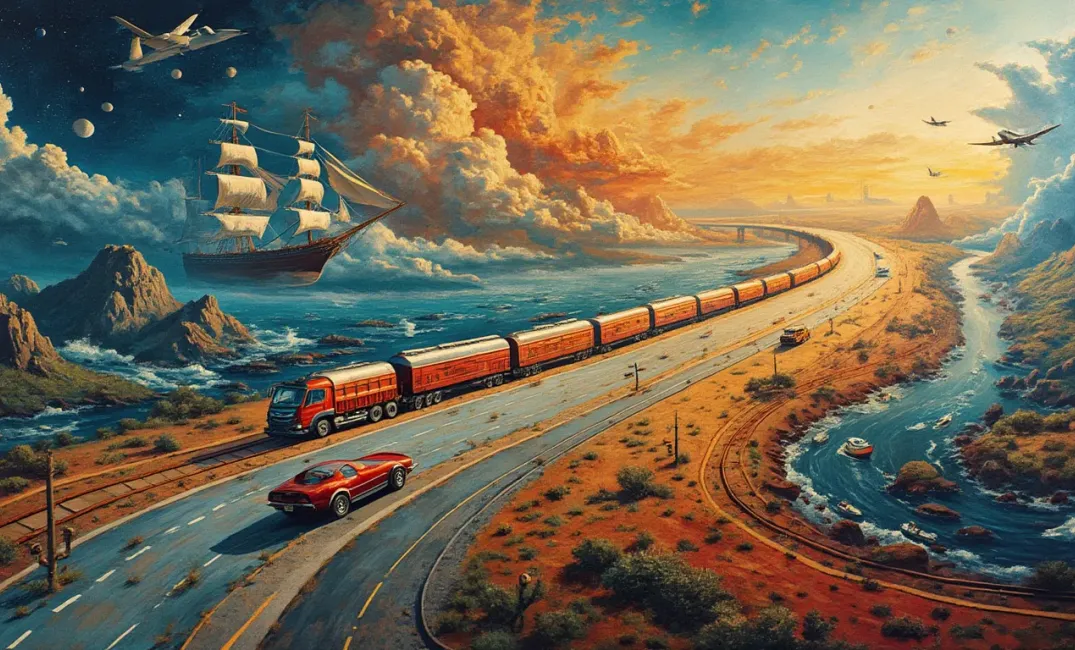Introduction: The Pathways of Progress
"Transportation is civilization." — Ralph Waldo Emerson
Throughout history, the legacy of human transportation has been a story of progress—of changing possibilities, connectivity, and innovation. As communities grew, economies expanded, and cultures mingled, transportation served as the backbone of human development, facilitating movement and exchange across vast distances. From humble beginnings with rudimentary wheels to sophisticated space travel, humanity's evolution in transportation reflects our quest for exploration, economic growth, cultural exchange, and the unyielding drive to overcome physical limitations. This entry explores the transformative journey of transportation throughout history, highlighting its impacts on societies, environments, and our collective future.
The Early Paths: Before the Wheel
Footpaths and Waterways
- Primitive Mobility: Early humans relied primarily on pedestrian movement to traverse landscapes. Nomadic tribes followed migratory patterns of animals, adapting to changing environments with agility and intuition.
- Navigating Waterways: Waterways served as natural highways long before the invention of the wheel. Early boats made from hollowed logs or animal skins facilitated travel and exchange across rivers and coastal areas, laying the groundwork for maritime navigation.
Emergence of Animal Domestication
- Beasts of Burden: Domestication of animals such as horses, donkeys, and camels transformed transportation, extending human reach. These animals not only eased the burdens of travel but also made transportation of goods over long distances more feasible.
- Trade and Communication: The increased mobility offered by animal domestication enabled the establishment of early trade networks, critical to cultural exchange and economic development.
Revolutionary Wheels: The Dawn of Mechanized Transport
Invention and Diffusion
- The Wheel's Inception: The invention of the wheel marked a pivotal advancement in transportation technology. Believed to have emerged in Mesopotamia circa 3500 BCE, the wheel enabled the development of carts and chariots, offering unparalleled efficiency in movement.
- Cultural Diffusion: The wheel's invention spread across civilizations along trade routes, influencing transportation systems from the Indus Valley to Egypt and Europe, progressively shaping economic and military strategies.
The Roman Roads
- Engineering Marvels: The Romans constructed an extensive network of roads, facilitating military movement and enabling the rapid dissemination of information across the empire. Their remarkable engineering—including sophisticated drainage systems—made these roads durable across broad and varied terrains.
- Commercial Expansion: Roman roads fostered commerce by linking distant provinces and cities, further enhancing cultural integration and regional stability.
The Age of Exploration: Sailing into the Unknown
Maritime Innovations
- The Age of Sail: Advancements in shipbuilding and navigation, including the development of the caravel, astrolabe, and compass, ushered in an era of exploration. European explorers ventured across uncharted seas, expanding known world realms and discovering new lands.
- Global Impact: Maritime exploration initiated irreversible shifts in global trade and cultural exchange, bringing about both collaboration and conflict, and etching new socioeconomic landscapes.
The Columbian Exchange
- Intercontinental Connectivity: The Columbian Exchange introduced widespread transfers of plants, animals, and technologies between continents. This global exchange catalyzed agricultural transformation and cultural infusion, setting the stage for the modern globalized world.
- The Transatlantic Ties: While intercontinental connections revolutionized economies and diets, they also involved profound challenges—most notably, forced migration and impacts on indigenous populations.
The Industrial Age: Steam and Steel
The Railway Revolution
- Engine of Change: The advent of the steam engine in the 18th century revolutionized land transportation. Railroads dramatically reduced travel time, facilitating mass movement of peoples and goods.
- Economic Catalyst: Railways expanded economic frontiers, opening new markets and fostering urbanization. Industry boomed as raw materials and finished goods moved across unprecedented distances.
The Automobile Ascendancy
- Birth of Automobility: The internal combustion engine gave rise to the automobile industry, making personal mobility commonplace. The development of highways and road infrastructure connected remote areas, reshaping urban and rural landscapes.
- Cultural Transformations: Automobiles symbolized freedom and progress, intertwining with cultural identities and influencing lifestyles throughout the 20th century.
The Age of Flight: Conquering the Skies
Innovation in Aviation
- The Wright Brothers: The 1903 flight of the Wright brothers' aircraft marked the dawn of aviation. From biplanes to jet engines, advancements in aerodynamics expanded the horizons of human travel.
- Commercial Aviation: As aviation technology matured, commercial airliners enabled rapid global connectivity, shrinking worlds and promoting international travel on an unprecedented scale.
Aerospace Frontiers
- Beyond the Atmosphere: The 20th century witnessed humanity's ventures beyond Earth, with achievements such as the Apollo moon landings and space stations highlighting the potential of aerospace transportation.
- Collaborative Exploration: Space exploration has evolved into collaborative efforts, exemplified by multinational endeavors and the growing ambition towards Mars colonization and beyond.
Future Horizons: Innovation and Sustainability
Toward a Green Future
- Sustainable Transport: In an era of climate awareness, sustainable transportation such as electric vehicles, high-speed rail, and renewable-powered aviation represents the future of cleaner mobility.
- Smart Cities and Public Transit: Advancements in digital infrastructure and autonomous vehicles inform the conception of smart cities, emphasizing integrated, efficient public transportation systems.
Interplanetary Ambitions
- Cosmic Pathways: The transportation of tomorrow extends beyond Earth, with commercial spaceflight and exploratory missions ushering humanity into an era of interplanetary travel and potential colonization.
- Ethical Considerations: Explorations emphasize the need for ensuring responsible innovation that respects celestial ecosystems and adheres to principles of equity and accessibility.
Conclusion: Transportation as a Beacon of Human Endeavor
"The journey of a thousand miles begins with one step." — Lao Tzu
The legacy of human transportation illustrates a continuing quest to transcend physical boundaries. From early land and sea explorations to cutting-edge space travel, transportation has bridged cultures, fueled economies, and inspired innovation.
As humanity stands on the cusp of new frontiers, transportation remains crucial in defining potential futures. Reflecting on past achievements and learning from challenges, we carry forward a legacy that embodies perseverance, creativity, and the daring curiosities of pioneers who dared to dream beyond horizons.
In capturing the narrative of transportation, we preserve a story of connectedness and continuity, one that lights the way for future travelers to chart their paths through the cosmos—a journey united by a shared commitment to progress, discovery, and hope.
AVIATION, SUSTAINABILITY, EXPLORATION, SPACE EXPLORATION, TECHNOLOGY, AUTOMOBILE, TRANSPORTATION, INNOVATION, HISTORY, RAILWAYS

